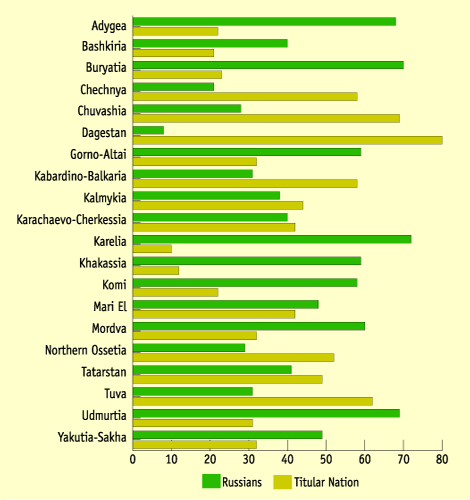
| Sociolingüística internacional |
Language policy in the Russian Federation: language diversity and national identity, by Marc Leprętre |
||||
| CONTINUA |
Therefore, after the break-up of the
Soviet State, Russia has made its first steps along the path towards the recovery of its
national identity and the reconstruction of its nationality. This new Russian identity is
based, broadly speaking, on the Orthodox religion and a nationalism that reproduces, for
lack of other models, the egalitarian, authoritarian and communitarian schemata of the
traditional Russian society. This search for a new identity takes place within the
framework of the traditional contradiction of a Russia split between its western
aspirations and its tendency towards isolation. Being used to living within its own myths,
Russian society looks for new social and moral points of reference to find a new position
as a nation, given the fact that the pre-Revolutionary myths based on religion, Empire and
autocracy were eliminated by the Bolshevik Revolution and were replaced by the new
Bolshevik myths (proletarian internationalism, construction of socialism), now also
disappeared. However, significant changes took place gradually in the subjective perception that the Russians had their own identity, mainly as a consequence of the increase and the radicalization of alien peoples’ defense of their rights which provoked an unavoidable confrontation between the center and the periphery. The Russians entered into direct competition with alien groups when claiming the solution of inequalities and grievances; from becoming aware of the huge financial aids granted to the Federated Republics, the delicate environmental situation, the moral corruption of the Soviet society as a whole, to the real extension of the Stalinist regime of terror and the arbitrariness’s of the previous decades, which resulted not only in an explosion of nationalist feelings in the Republics, but also encouraged the leaders of the periphery to elude their responsibilities by means of systematic attacks on the center and the federal authorities identified with the Russians. The latter, seeing that they were associated with a policy and authorities that for seven decades had not treated them in any way substantially different from the way they treated other Republics and, in addition, seeing themselves as being deprived of national political, economic and cultural institutions because of the overlapping of the Soviet and Russian institutions, launched a revival of a deeply ethnical Russian nationalism. The emerging of nationalist movements at the heart of the RSFSR (Tatarstan, Yakutia-Sakha, Chechnya, Tuva, Buryatia, Dagestan, Northern Ossetia, etc.) provoked a chain reaction in the Russian population, in such a way that many Russian nationalist movements that arose under the protection of the perestroika started, unlike their predecessors of the 70’s, to employ the centrifuge tactics of the peripheral nationalist movements. In such a situation, faced with the intensification of the anti-Russian xenophobic feelings in the Transcaucasian and Centro-Asiatic Republics and the establishment of new legislations as regards languages and education that benefited autochthonous languages, the Russian nationalists organized themselves by creating popular fronts, as was happening in the Baltic countries or in Transcaucasia. This radicalization of Russian nationalism provoked a double confrontation between the RSFSR and the Federated Republics, on the one hand, and between the very same RSFSR and the federal authorities, on the other. The fact that after the break-up of the USSR the Russian Federation still existed as a sole territorial entity with such a complex multiethnic composition gave rise among the Russian population to a feeling that their country, now an orphan of reference points on which to draw and construct a new identity, had simply become what was left of the USSR, once any influence on the other Federated Republics, some of which (Belarus and Ukraine) constituted some of the symbolic references of Great Russia since the X century, had been lost. The following graph shows the ethnic composition in the autonomous republics of the Russian Federation. Figure 1. The ethnic composition in the Russian Federation (1989)
Own elaboration from the data provided by Natsionalnii Sostav SSSR (1991)
|
